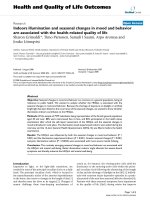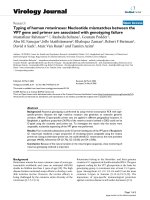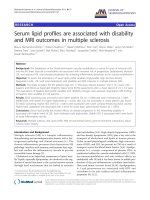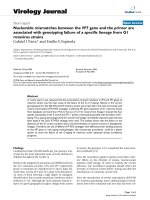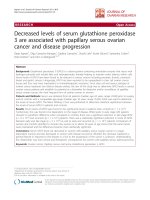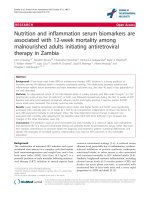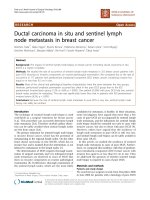BRCA1 and ERCC1 mRNA levels are associated with lymph node metastasis in Chinese patients with colorectal cancer
Bạn đang xem bản rút gọn của tài liệu. Xem và tải ngay bản đầy đủ của tài liệu tại đây (497.11 KB, 8 trang )
Yuanming et al. BMC Cancer 2013, 13:103
/>
RESEARCH ARTICLE
Open Access
BRCA1 and ERCC1 mRNA levels are associated
with lymph node metastasis in Chinese patients
with colorectal cancer
Lu Yuanming1,2†, Zhang Lineng3†, Song Baorong1,2†, Peng Junjie1,2 and Cai Sanjun1,2*
Abstract
Background: Although both excision repair cross-complementing group 1 (ERCC1) and breast cancer susceptibility
gene 1 (BRCA1) can be effective biomarkers for chemosensitivity in primary malignant tumors, their applicability to
metastases is poorly understood. Here, ERCC1 and BRCA1, which are linked to lymph node metastasis (LNM) in
colorectal cancer (CRC), were evaluated in primary CRC samples from Chinese patients with LNM (LNM CRC) or
without LNM (non-LNM CRC). mRNA levels of ERCC1 and BRCA1 in CRC samples, and their relationships to primary
CRC and LNM, were also examined.
Methods: Differences in BRCA1 and ERCC1 gene expression between primary CRC with or without LNM were
assessed in CRC samples from 120 Chinese patients, using real-time polymerase chain reaction. Relationships
between ERCC1 and BRCA1 expression and clinicopathological parameters and prognoses were also examined.
Results: ERCC1 and BRCA1 were significantly down-regulated in LNM CRC compared with non-LNM CRC. Downexpression of ERCC1 and BRCA1 was significantly associated with LNM (P < 0.001), advanced TNM stage (P < 0.001),
and decreased 5-year overall survival rate (P < 0.001). Univariate and multivariate analyses showed ERCC1 and
BRCA1 expression as independent predictors of recurrence and survival in CRC patients (P < 0.05).
Conclusions: ERCC1 and BRCA1 mRNA expression levels correlate inversely to CRC metastasis. ERCC1 and BRCA1
might serve as biomarkers for LNM and as prognostic indicators for CRC; their down-expressions are predictors of
poor outcome in CRC patients.
Keywords: Biomarkers, RT-PCR, Chemosensitivity
Background
The incidence of colorectal cancer (CRC) is higher in the
United States than in China, where it is the third leading
cause of cancer-related death in both sexes. However, its
rate in China has increased steeply in recent years. Most
Chinese patients with CRC have metastatic disease at
diagnosis; earlier detection of their disease would greatly
improve their odds of survival [1]. Although recent
advances in chemotherapy have prolonged survival of
patients with advanced disease, these treatments are
* Correspondence:
†
Equal contributors
1
Department of Colorectal Cancer Center, Fudan University Shanghai Cancer
Center, Dong An Road 270, Shanghai 200032, China
2
Department of Oncology, Shanghai Medical College Fudan University, Dong
An Road 270, Shanghai 200032, China
Full list of author information is available at the end of the article
handicapped by the lack of early-presenting biomarkers
for CRC metastasis. Exploration of candidate genes to
establish potent biomarkers for earlier detection of lymph
node metastasis (LNM) would permit adoption of more
suitable chemotherapeutic regimens, although prognoses
of patients with CRC are also affected by such factors as
tumor localization, quality of surgical procedures, gender,
age, and patient’s overall performance status. Monitoring
of high-risk individuals increases their 5-year survival rate
and decreases chances of cumulative recurrence.
The excision repair cross-complementing group 1 gene
(ERCC1) is an essential member of the nucleotide excision
repair (NER) pathway, which accounts for most platinum–DNA adduct repairs. ERCC1 has been established
as a useful molecular marker for NER activity. Early studies have shown that higher ERCC1 mRNA levels are
© 2013 Yuanming et al.; licensee BioMed Central Ltd. This is an Open Access article distributed under the terms of the
Creative Commons Attribution License ( which permits unrestricted use,
distribution, and reproduction in any medium, provided the original work is properly cited.
Yuanming et al. BMC Cancer 2013, 13:103
/>
associated with more active DNA repair processes in
various tissues [2]. Interestingly, ERCC1 expression is also
associated with cellular and clinical resistance to platinum
compounds and to platinum-based chemotherapy, including those for lung and gastric malignancies [3,4].
Breast cancer susceptibility gene 1 (BRCA1) is an essential component of several DNA-repair pathways that affect
homologous recombination repair, non-homologous
repair and NER. BRCA1 is considered to be a differential
modulator of tumor response to cisplatin and taxanes
[5-7], and BRCA1 levels are reportedly associated with
chemosensitivity to cisplatin [8] and taxanes [9,10].
Although the aforementioned studies suggest that
both ERCC1 and BRCA1 are effective biomarkers for
chemosensitivity in primary tumors, information on their
expression in metastases is limited. Therefore, we explored the applicability of these biomarkers as predictive
factors in CRC metastasis.
The current study is thus designed to investigate the
possibility of using ERCC1 and BRCA1 as biomarkers in
CRC metastatic specimens from Chinese patients. We
examined mRNA levels of ERCC1 and BRCA1 in CRC
with LNM (LNM CRC) or without LNM (non-LNM
CRC), using real-time quantitative polymerase chain reaction (RT-PCR). We also verified the relationship of
ERCC1 and BRCA1 levels on prognosis in CRC patients.
Methods
Page 2 of 8
chloroform-isoamyl alcohol, followed by precipitation with
isopropanol in the presence of glycogen and sodium
acetate, resuspension in diethyl pyrocarbonate water
(Ambion Inc., Austin, TX), and treatment with DNAse I
(Ambion Inc., Austin, TX) to avoid DNA contamination.
Complementary DNA was synthesized using Maloney
Murine Leukemia Virus retrotranscriptase enzyme. Template cDNA was added to Taqman Universal Master Mix
(AB, Applied Biosystems, Foster City, CA) in a 12.5-μl
reaction with specific primers and probe for each gene.
Primer and probe sets were designed using Primer Express
2.0 Software (AB) and RefSeq sequences (i.
clm.cih.gob/gene). Quantification of gene expression was
carried out using the ABI Prism 7900HT Sequence Detection System (AB).
Relative gene expression quantification was calculated
according to the comparative cycle threshold (Ct)
method [12] using β-actin as an endogenous control and
commercial RNA controls (Stratagene, La Jolla, CA) as
calibrators. Final results were determined as follows:
2– (ΔCt sample – ΔCt calibrator), where ΔCt values of the
calibrator and sample are determined by subtracting the
Ct value of the target gene from the value of the β-actin
gene. In all experiments, only triplicates with a standard
deviation of the Ct value < 0.20 were accepted. In addition,
for each sample analyzed, a retrotranscriptase minus control was run in the same plate to assure lack of genomic
DNA contamination.
Patient population and characteristics of tissue samples
Samples from a total of 120 patients with colorectal carcinoma were collected from surgical resections performed
in our hospital (Fudan University Shanghai Cancer Center,
Shanghai, China), after obtaining informed consent. None
of the patients received chemotherapy or radiotherapy
before surgery. Resected specimens were reviewed by
two senior pathologists according to the criteria described in the American Joint Committee on Cancer’s
Cancer Staging Manual (7th edition, 2010) [11]. At
least 12 lymph nodes each were retrieved from patients
with non-LNM CRC, none of whom had distant metastasis. The fresh colorectal tumor tissues were obtained
immediately after surgery, washed twice with chilled
phosphate-buffered saline (PBS), immediately stored in
liquid nitrogen and at –80°C in our tissue bank until
further use. Ethical approval was obtained from the
Cancer Center Research Ethics Committee of Fudan
University.
Gene expression analysis by real-time quantitative PCR
ERCC1 and BRCA1 gene expression was assessed in SYBR
Green Supermix (Promega). Samples were treated using a
laser capture microdissection technique (Palm Microlaser,
Oberlensheim, Germany) to ensure a minimum of 80% of
tumor tissue. RNA was then extracted with phenol-
Western blotting
Briefly, 30-μg protein samples from each case were separated by 10% sodium dodecyl sulfate polyacrylamide gel
electrophoresis and subsequently transferred to poly
(vinylidene fluoride) membranes. The membranes were
incubated with rabbit polyclonal antibody against ERCC1
or BRCA1 (1:1000 dilution; Abcam, Cambridge, UK) and
then incubated with a horseradish-peroxidase-conjugated
secondary antibody (1:100 dilution; Proteintech, Chicago,
IL, USA). β-Actin was detected simultaneously as a loading control (anti-β-actin, 1:1000 dilution; Kangchen,
Beijing, China). All blots were visualized using an ECL
detection system (Amersham, Arlington Heights, IL,
USA) and quantitated by densitometry using an LAS3000 imager.
Immunohistochemistry
Both ERCC1 and BRCA1 expression were examined
immunohistochemically using paraffin-embedded tissues.
In brief, 4-μm-thick tissue sections were heated in 6.5 mmol/L citrate buffer (pH 6.0) at 100°C for 28 min, and incubated with antibodies against ERCC1 or BRCA1 (1:200
dilution). Immunostaining was performed using the DAKO
En-Vision System (Dako Diagnostics, Zug, Switzerland). In
the negative control group, PBS was used instead of
Yuanming et al. BMC Cancer 2013, 13:103
/>
Page 3 of 8
primary antibody. Expression was scored by two independent experienced pathologists. Each sample was
graded according to intensity and extent of staining.
The intensity of staining was scored as 0 (no staining),
1 (weak staining), and 2 (strong staining). The extent of
staining was based on the percentage of positive tumor
cells: 0 (no staining), 1 (1–25%), 2 (26–50%), 3 (51–75%),
and 4 (76–100%). These two scores were added together
for a final score. The case was considered negative if the
final score was 0 or 1 (−) or 2 or 3 (±), and positive if the
score was 4 or 5 (+) or 6 or 7 (++). In most cases, the
two reviewers provided consistent results. Any inconsistencies were resolved by discussion to achieve a consensus score.
A
LNM
LNM
BRCA1
β-actin
β-actin
1.1
**
0.7
0.6
0.5
0.4
0.3
0.2
0.9
0.8
0.7
0.6
0.5
0.4
0.3
0.2
0.1
0
0
LNM CRC
non-LNM CRC
100
r=0.516
P<0.001
90
80
70
60
50
40
30
20
10
0
0
10
20
30
40
50
60
70
80
**
1
0.1
LNM CRC
BRCA1
non-LNM CRC
ERCC1
Relative BRCA1 mRNA level
Realtive ERCC1 mRNA level
The PCR analysis results were expressed as ratios between two absolute measurements (gene of interest/ internal reference gene). Student’s t test was used to
evaluate differences in ERCC1 and BRCA1 expression
between LNM CRC and non-LNM CRC. The χ2 test was
used to assess relationships between ERCC1 and BRCA1
expression and clinicopathological factors. The cumulative recurrence and survival probability were estimated
using the Kaplan–Meier method; differences were calculated by log-rank test. Prognostic factors were determined using Cox regression analysis. Recurrence-free
and overall survival times were calculated from the first
resection of the primary tumor to first evidence of
non-LNM CRC
0.8
B
Statistical analysis
90
100
ERCC1
Figure 1 Confirmation of the overexpression of BRCA1 and ERCC1 in colorectal cancer.
non-LNM CRC
Yuanming et al. BMC Cancer 2013, 13:103
/>
Page 4 of 8
recurrence or to death from any cause, respectively. The
diagnosis of recurrence was based on the typical features
presented on computed tomography/magnetic resonance
imaging and elevated serum carcinoembryonic antigen. All P values were two-sided; P < 0.05 was considered to be significant. Statistical analyses used SPSS
13.0 software.
Results
Confirmation of ERCC1 and BRCA1 expression in nonLNM and LNM CRC specimens
Real-time quantitative PCR was used to analyze ERCC1
and BRCA1 expression in different groups of CRC. Relative
gene expression quantifications were calculated according
to the comparative Ct method using β-actin as an endogenous control. Median ERCC1 mRNA expression was 6.6 in
non-LNM CRC (range: 2.8–8.52; n = 60) and 3.4 in LNM
CRC (range: 2.2–8.16; n = 60). Median BRCA1 mRNA
expression was 4.5 in non-LNM CRC (range: 3.21–10.52;
n = 60) and 2.6 in LNM CRC (range 1.3–10.16; n = 60).
Both ERCC1 and BRCA1 mRNA expression were downregulated in LNM CRC compared with non-LNM CRC.
Significant correlations between ERCC1 and BRCA1 expression levels (Spearman r = 0.516; P < 0.001) are shown in
Figure 1.
To compare the RT-PCR results with ERCC1 and
BRCA1 protein levels, we extended the experiments in the
same samples described above with western blot. Thirty
micrograms of total proteins from LNM CRC and nonLNM CRC were analyzed using western blotting. Expression of ERCC1 and BRCA1 was dramatically higher in
non-LNM CRC compared with LNM CRC (P < 0.001). A
representative western blotting result is presented in
Figure 1A.
Table 2 ERCC1 expression and relationship with
clinicopathological factors in CRC
Clinicopathological
factors
Table 1 BRCA1 expression and relationship with
clinicopathological factors in CRC
Clinicopathological
factors
n
BRCA1 expression
Negative
Positive
61
27
34
Female
59
26
33
≤ 60
80
40
40
> 60
40
16
24
≤5
84
40
44
>5
36
18
18
P
value1
45
20
25
75
32
43
I-II
92
48
44
III-IV
28
10
18
42
21
21
78
39
39
N0
42
22
20
N1-2
78
66
12
I-II
42
22
20
III-IV
78
67
11
0.205
P
value1
Male
61
29
32
Female
59
29
30
≤ 60
80
38
42
> 60
40
20
20
0.325
0.367
Tumor size (cm)
0.236
≤5
84
42
42
>5
36
16
20
Colon
45
19
26
Rectum
75
37
38
I-II
92
52
40
III-IV
28
12
16
T1-2
42
20
22
T3-4
78
41
37
N0
42
18
24
N1-2
78
70
8
I-II
42
21
21
III-IV
78
65
13
0.157
Tumor location
Tumor size (cm)
0.134
0.521
Tumor differentiation2
Tumor location
Rectum
Positive
Age (yr)
Age (yr)
Colon
ERCC1 expression
Negative
Sex
Sex
Male
n
0.508
0.124
Tumor status2
2
Tumor differentiation
0.132
Lymph node metastasis2
Tumor status2
T1-2
T3-4
0.404
0.384
< 0.001
TNM stage2
2
Lymph node metastasis
< 0.001
Statistical analysis was estimated with χ2 test, and P < 0.05 was considered
statistically significant;
2
Grading of differentiation status and TNM classification for colorectal cancer
were based on the American Joint Committee on Cancer Cancer Staging
Manual (7th edition, 2009). The tumors were classified into two groups: well
differentiated (grades I and II) and poorly differentiated (grades III and IV).
1
TNM stage2
< 0.001
< 0.001
Yuanming et al. BMC Cancer 2013, 13:103
/>
Association of ERCC1 and BRCA1 expression with
clinicopathological features and postoperative prognosis
of patients with CRC
To study the relationships between ERCC1 or BRCA1
expression and clinicopathological features, and to assess
whether ERCC1 or BRCA1 levels could predict clinical
outcomes for patients with CRC, an immunohistochemistry study was used to confirm the PCR results, using
the same samples.
Statistical analysis showed positive expressions of
ERCC1 and BRCA1 were significantly associated with
LNM, and advanced TNM stage (P < 0.001). However,
no significant correlations were observed between
ERCC1 or BRCA1 expression and other clinicopathological parameters of sex, age, tumor size, tumor differentiation and tumor location (Tables 1 and 2).
Furthermore, we have found that patients whose CRC
specimens were negative for ERCC1 or BRCA1 had significantly poorer prognoses than those with ERCC1+/BRCA1+
CRC (Figure 2). The 5-year cumulative recurrence rate was
significantly higher for patients in the ERCC1+/BRCA1+
Page 5 of 8
group (P < 0.05). The 5-year estimated probability cumulative survival rate was also different in both group patients with BRCA1– CRC or ERCC1– CRC than in the
ERCC1+/BRCA1+ group (P < 0.05). Univariate analyses
revealed that LNM, TNM stage, ERCC1 expression and
BRCA1 expression were related to recurrence and overall survival. In multivariate analysis, LNM, TNM stage,
ERCC1 expression and BRCA1 expression were also independent prognostic factors for recurrence and overall
survival (P < 0.05, Table 3).
Discussion
CRC is an aggressive cancer, with 300,000 newly diagnosed cases and 200,000 CRC-caused deaths each year
in Europe and the United States [13]. Biomarkers that
could help diagnose CRCs before metastases occur can
lead to earlier, more successful treatments. Moreover,
accurate biomarkers for metastases could aid clinicians
in identifying the most appropriate chemotherapies for
patients with CRC who have had resections; up to 50%
of patients who undergo potentially curative surgeries
Figure 2 Expression of ERCC1 and BRCA1 correlated with poor prognosis in colorectal cancer patients.
Yuanming et al. BMC Cancer 2013, 13:103
/>
Page 6 of 8
Table 3 Univariate and multivariate analyses of recurrence and survival (Cox regression)
Variables
Recurrence
Survival
HR (95% CI)
P value
HR (95% CI)
P value
0.813 (0.479-1.518)
0.604
0.829 (0.424-1.618)
0.662
1.506 (0.804-2.712)
0.163
1.822 (0.947-3.528)
0.065
0.876 (0.163-0.665)
0.687
0.880 (0.438-1.723)
0.704
0.812 (0.445-1.423)
0.518
0.904 (0.476-1.734)
0.778
1.212 (0.654-2.308)
0.501
1.151 (0.576-2.358)
0.650
0.866 (0.475-1.618)
0.687
1.020 (0.504-2.028)
0.904
2.707 (1.502-4.912)
0.011
2.812 (1.413-5.509)
0.012
3.554 (1.932-6.526)
<0.001
3.385 (1.677-6.843)
<0.001
3.556 (1.919-6.932)
<0.001
4.038 (1.913-8.712)
<0.001
3.244 (1.191-7.012)
<0.001
4.033 (1.906-8.512)
<0.001
0.210 (0.051-0.758)
0.018
0.196 (0.041-0.852)
0.028
8.905 (2.072-38.190)
0.003
9.037 (1.703-48.105)
0.010
2.673 (1.134-6.011)
0.018
3.011 (1.236-7.95)
0.031
2.401 (1.115-5.722)
0.013
2.844 (1.106-7.44)
0.021
Univariate analysis
Sex
Male/female
Age (yr)
≤ 60/> 60
Tumor size (cm)
≤ 5/> 5
Tumor location
Colon/rectum
Tumor differentiation
I-II/III-IV
Tumor status
T1-2/T3-4
Lymph node metastasis
N0/N1-2
TNM stage
I-II/III-IV
ERCC1 expression
Negative/positive
BRCA1 expression
Negative/positive
Multivariate analysis
LNM
N0/N1-2
TNM stage
I-II/III-IV
ERCC1 expression
Negative/positive
BRCA1 expression
Negative/positive
HR: Hazard ratio; CI: Confidence interval.
ultimately suffer recurrence and die of metastatic
disease [14].
More than 85% of CRCs have been attributed to environmental factors, which can produce adducts, damage
and strand breaks in DNA. Damaged DNA can be removed and recovered by DNA-repairing enzymes, which
are critical for the genome protection and cancer prevention [15,16]; the relationship between DNA repair
genes and various cancers has been widely studied [17].
Adjuvant therapy is important to the clinical outcomes
of the stage II–III cases that represent approximately
70% of CRC patients; adjuvant treatment following primary surgery could be improved by prognostic biomarkers. In this study, we investigated whether ERCC1
and BRCA1 could be such biomarkers and found that
their down-expression is associated with poor prognosis
in CRC.
ERCC1 is an endonuclease that helps perform NER of
DNA [18]. We found negative expression of ERCC1 to
correlate with LNM and advanced TNM stage, implying
that ERCC1 decreases CRC metastasis, and by extension,
that its reduced expression might be an early event in
colorectal carcinogenesis. Patients with CRC that expresses negative ERCC1 have been shown to have high
cumulative recurrence and low cumulative survival. On
the other hand, the NER pathway is thought to repair
DNA damage cause by platinum agents; several studies
demonstrated an inverse relationship between impaired
Yuanming et al. BMC Cancer 2013, 13:103
/>
DNA-repair capacity and increased response rates to
platinum drugs. Patients with CRC whose tumors show
low levels of ERCC1 gene amplification reportedly have
superior overall survival if treated with fluorouracil/
oxaliplatin. However, many factors affect metastasis.
ERCC1 could be restrained or promoted by other genes,
which could influence LNM somehow; this area is
already the subject of advanced research.
BRCA1 also has a role in DNA repair similar to that
of ERCC1. Variants of BRCA1 are markers for breast
and ovarian cancers, but it is unclear whether mutations
in this gene increase the risk of CRC. Our data show
that BRCA1 might be involved in CRC metastasis, as
with ERCC1, and therefore it is a potential biomarker
for CRC. However, changes in BRCA1 expression seem
to be less sensitive to early-stage disease, compared with
ERCC1, although changes in expressions of both proteins appear to correlate with LNM. This correlation
between ERCC1 or BRCA1 expression and CRC metastasis has been suggested recently [19,20], but no statistical association could be established between reduced
expression of ERCC1 or BRCA1 and tumor stage and
lymph node involvement. Our data show relationships
between negative ERCC1 or BRCA1 expression and clinical CRC LNM, implying that both ERCC1 and BRCA1
are involved in CRC metastasis, and that reduced
expression of these proteins are early events in colorectal carcinogenesis.
Arguably, the most important relationship we found
was that between negative ERCC1 or BRCA1 expression
in CRC and poor patient survival. We found negative
ERCC1 or BRCA1 expression to correlate with LNM
and advanced TNM stage, which suggests that ERCC1
and/or BRCA1 affect CRC progression from localized to
LNM disease. In addition, patients with negative ERCC1
or BRCA1 expression in CRC have increased risk of
recurrence and significantly reduced overall survival
rates. Univariate and multivariate analyses indicate that
ERCC1 or BRCA1 expression could serve as independent prognostic factors for recurrence and overall survival
in patients with CRC.
Conclusions
Our quantitative analysis of mRNA and protein expression showed ERCC1 and BRCA1 to be significantly
negatively expressed in LNM CRC. Further evaluation
using the same sample set suggests that ERCC1 and
BRCA1 are biomarkers for LNM and predictors of prognosis in CRC.
Abbreviations
BRCA1: Breast cancer susceptibility gene 1; CRC: Colorectal cancer;
ERCC1: Excision repair cross-complementing group 1; LMN: Lymph node
metastasis; LMN CRC: Colorectal cancer with lymph node metastasis; non-
Page 7 of 8
LNM CRC: Colorectal cancer without lymph node metastasis; PBS: Phosphatebuffered saline; RT-PCR: Real-time quantitative polymerase chain reaction.
Competing interests
The authors declare that they have no competing interests.
Authors’ contributions
Lu Yuanming designed the study and took part in the experiments. Zhang
Lineng and Song Baorong performed most of the experiments. Peng Junjie
was responsible for sample collection. Cai Sanjun directed the study. All
authors read and approved the final manuscript.
Author details
1
Department of Colorectal Cancer Center, Fudan University Shanghai Cancer
Center, Dong An Road 270, Shanghai 200032, China. 2Department of
Oncology, Shanghai Medical College Fudan University, Dong An Road 270,
Shanghai 200032, China. 3Department of Molecular biology and
Biochemistry, Shanghai Medical College of Fudan University, Shanghai
200032, China.
Received: 29 May 2012 Accepted: 13 December 2012
Published: 6 March 2013
References
1. Jemal A, Siegel R, Ward E, Hao Y, Xu J, Thun MJ: Cancer statistics, 2009.
CA Cancer J Clin. 2009, 59:225–49.
2. Vogel U, Dybdahl M, Frentz G, Nexo BA: DNA repair capacity inconsistency
between effect of over-expression of five NER genes and the correlation
to mRNA levels in primary lym phocytes. Mutat Res 2000, 461:197–210.
3. Kwon HC, Roh M, Oh S, Kim SH, Kim M, Kim JS, Kim HJ: Prognostic value of
expression of ERCC1, thymidylate synthase, and glutathione Stransferase P1 for 5-fluorouracil/oxaliplatin chemotherapy in advanced
gastric cancer. Ann Oncol 2007, 18:504–9.
4. Park DJ, Lenz HJ: Determination of chemosensitivity in gastric cancer.
Curr Opin Pharmacol 2006, 6:337–344.
5. Quinn JE, Kennedy RD, Mullan PB, Gilmore PM, Carty M, Johnston PG, Harkin DP:
BRCA1 functions as a differential modulator chemotherapy-induced
apoptosis. Cancer Res 2003, 63:6221–8.
6. Mullan PB, Quinn JE, Harkin DP: The role of BRCA1 in transcriptional
regulation and cell cycle control. Oncogene 2006, 25:5854–63.
7. Kennedy RD, Quinn JE, Mullan PB, Johnston PG, Harkin DP: The role of
BRCA1 in the cellular response to chemotherapy. J Nat Cancer Inst 2004,
96:1659–68.
8. Taron M, Rosell R, Felip E, Mendez P, Souglakos J, Ronco MS, Queralt C,
Majo J, Sanchez JM, Sanchez JJ, Maestre J: BRCA1 mRNA expression levels
as an indicator of chemoresistance in lung cancer. Hum Mol Genet 2004,
13:2443–9.
9. Kennedy RD, Quinn JE, Johnston PG, Harkin DP: BRCA1: mechanisms of
inactivation and implications for management of patients. Lancet 2002,
360:1007–14.
10. Kurebayashi J, Yamamoto Y, Kurosumi M, Okubo S, Nomura T, Tanaka K, Sonoo
H: Loss of BRCA1 expression may predict shorter time-to-progression in
metastatic breast cancer patients treated with taxanes. Anticancer Res 2006,
26:695–702.
11. Chambers AF, Groom AC, Macdonald IC: Dissemination and growth of
cancer cells in metastatic sites. Nat Rev Cancer 2002, 2:563–572.
12. Livak KJ, Schmittgen TD: Analysis of relative gene expression data using
real-time quantitative PCR and the 2(−Delta Delta C(T)) method.
Methods 2001, 25:402–8.
13. Vineis G, Talaska C, Malaveille H, Bartsch T, Martone P, Sithisarankul P:
Strickland. DNA adducts in urothelialcells: relationship with biomarkers of
exposure to arylaminesand polycyclic aromatic hydrocarbons from tobacco
smoke. Int J Cancer 1996, 65:314–316.
14. Hou SM, Falt S, Angelini S, Yang K, Nyberg F, Lambert B, Hemminki K: The
XPD variant alleles areassociated with increased aromatic DNA adduct
level and lungcancer risk. Carcinogenesis 2002, 23:599–603.
15. Matullo G, Guarrera S, Carturan S, Peluso M, Malaveille C, Davico L, Piazza A,
Vineis P: DNA repair gene polymorphisms, bulky DNA adducts in white
blood cells and bladdercancer in a case–control study. Int J Cancer 2001,
92:562–567.
Yuanming et al. BMC Cancer 2013, 13:103
/>
Page 8 of 8
16. Liu G, Zhou W, Christiani DC: Molecular epidemiology of non-small cell
lung cancer. Semin Respir Crit Care Med 2005, 26:265–272.
17. Reardon JT, Vaisman A, Chaney SG, Sancar A: Efficient nucleotide excision
repair of cisplatin, oxaliplatin, and Bis-aceto-ammine-dichlorocyclohexylamine-platinum (IV) (JM216) platinum intrastrand DNA
diadducts. Cancer Res 1999, 59:3968–71.
18. Metzger R, Leichman CG, Danenberg KD, Danenberg PV, Lenz HJ, Hayashi K,
Groshen S, Salonga D, Cohen H, Laine L, Crookes P, Silberman H, Baranda J,
Konda B, Leichman L: ERCC1 mRNA levels complement thymidylate
synthase mRNA levels in predicting response and survival for gastric
cancer patients receiving combination cisplatin and fluorouracil
chemotherapy. J Clin Oncol 1998, 16:309–16.
19. Shirota Y, Stoehlmacher J, Brabender J, Xiong YP, Uetake H, Danenberg KD,
Groshen S, Tsao-Wei DD, Danenberg PV, Lenz HJ: ERCC1 and thymidylate
synthase mRNA levels predict survival for colorectal cancer patients
receiving combination oxaliplatin and fluorouracil chemotherapy.
J Clin Oncol 2001, 19:4298–304.
20. Heike G, Mit D, Lisa B, Nicola M, Karen M, Olaf H, Helmut EG, Wolfram M:
Expression of DNA double-strand break repair proteins ATM and BRCA1
predicts survival in colorectal cancer. Clin Cancer Res 2006,
12(5):1494–1500.
doi:10.1186/1471-2407-13-103
Cite this article as: Yuanming et al.: BRCA1 and ERCC1 mRNA levels are
associated with lymph node metastasis in Chinese patients with
colorectal cancer. BMC Cancer 2013 13:103.
Submit your next manuscript to BioMed Central
and take full advantage of:
• Convenient online submission
• Thorough peer review
• No space constraints or color figure charges
• Immediate publication on acceptance
• Inclusion in PubMed, CAS, Scopus and Google Scholar
• Research which is freely available for redistribution
Submit your manuscript at
www.biomedcentral.com/submit

